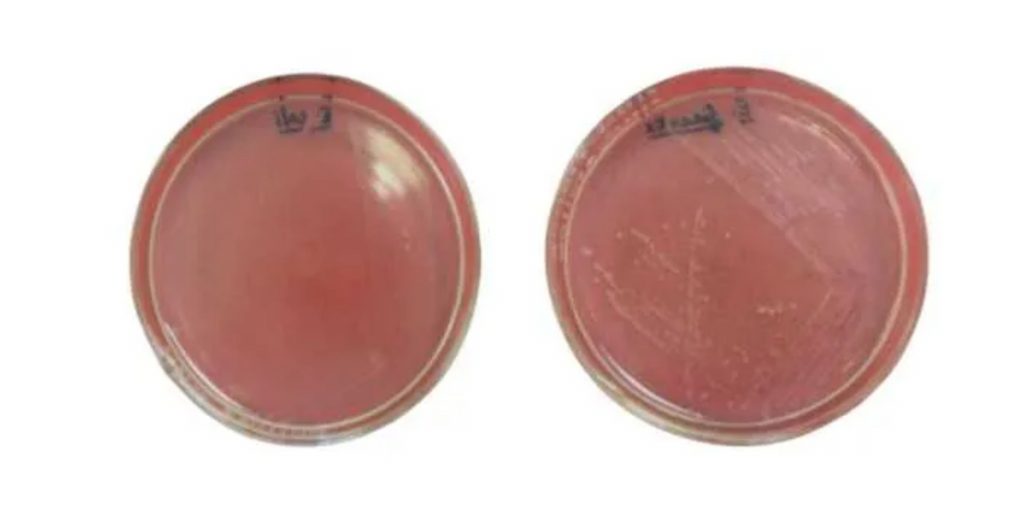Table of Contents
A selective medium called phenylethyl alcohol (PEA), is used to cultivate Gram positive organisms, especially cocci, in a sample containing pathogens. Phenylethyl alcohol is the active ingredient that inhibits or significantly reduces growth of Gram-negative organisms. It interferes with DNA synthesis. Staphylococcus aureus is a Gram positive organism that grows on PEA, while Serratia marcescens is a Gram negative organism.
Principle of Phenylethyl Alcohol Agar
A selective medium, Phenylethyl alcohol (PEA), allows the growth of gram positive cocci and inhibits most gram negative organisms. PEA changes the membrane permeability of Gram-negative bacteria, allowing for the influx of other molecules. This causes large amounts of cellular potassium to leak into the cells, which ultimately leads to disruption or inhibition in DNA synthesis in Gram-negative bacteria.
Composition of PEA
Suppliers can purchase PEA agar medium as a premixed product. To prepare the plates, you should follow the manufacturer’s instructions. Premade agar plates can also be made from this media.
| Ingredients | Amounts (gm/L) |
| Pancreatic digest of casein | 15.0 g |
| Papic digest of soybean meal | 5.0 g |
| Sodium chloride | 5.0 g |
| Agar | 15.0 g |
| Sterile defibrinated sheep blood | 50.0 ml |
| β-Phenylethyl alcohol | 2.5 g |
| Distilled water | 1 liter |
Final pH at 25°C 7.3 ± 0.2.
Preparation of the Media
You can make phenylethyl alcohol (PEA) with or without 5% sheep’s blood. To enhance the growth anaerobic bacteria, five percent sheep blood can be added to the base medium.
- Mix the ingredients in 1 liter of distilled Water.
- To dissolve the mixture completely, heat with constant stirring.
- Autoclave for 15 minutes at 121°C and 15 lb/in2.
- Keep it at 45 degrees Celsius
- Mix well.
- Allow the melted medium to cool in sterilized Petri dishes.
Step 5. is required when preparing PEA with 5% sheepblood supplementation.
Note:
| Characteristics | PEA without sheep blood | PEA with 5% sheep blood |
| Color of the prepared media | clear to slightly hazy and pale yellow. | firm, opaque, and red in color. |
| Shelf live | prepared plates can be stored in the refrigerator for up to 4 weeks before use. | prepared plates could be stored in the refrigerator up to 1 week before use. |
Culture Technique
Inoculation
Before inoculation, store media should be at room temperature.
Aseptically transfer potential mixed cultures onto the surface using a spreading or streaking technique depending on the purpose of the study.
Incubation
Plates should be incubated for between 24 and 48 hours at 35degC +-2 degC in an appropriate environment. According to the purpose of the study, PEA blood-agar plates can either be incubated under anaerobic or aerobic conditions. High CO2 conditions allow bacteria to be detected and can also promote the growth of most other pathogens.
Interpretation of results
The colonies will form on the agar plates after proper incubation. While Gram-positive bacteria can grow well, most gram-negative bacteria cannot or are only partially inhibited.

Left: Escherichia coli. Right: Staphylococcus aureus
Image source: Cheeptham and Farday, ASM MicrobeLibrary
Growth Response
Growth response to some gram positive and gram negative bacteria on PEA agar
| Organism | Gram reaction | Growth response |
| Escherichia coli | Gram-negative | Inhibited |
| Enterobacter aerogenes | Gram-negative | Inhibited |
| Proteus mirabilis | Gram-negative | Markedly inhibited. Swarming inhibition. |
| Pseudomonas aeruginosa | Gram-negative | Partially inhibited |
| Salmonella enteritidis | Gram-negative | Inhibited |
| Bacillus sp. | Gram-positive | Good |
| Clostridium perfringens | Gram-positive | Partially inhibited |
| Enterococcus faecalis | Gram-positive | Good |
| Micrococcus luteus | Gram-positive | Good |
| Staphylococcus aureus | Gram-positive | Good |
| Streptococcus pneumoniae | Gram-positive | Good |
| Streptococcus pyogenes | Gram-positive | Good |
Quality Control
After checking for correct pH, colour, depth, and sterility, the following organisms are used to determine the growth performance of the completed medium.
| Organism | Expected Result |
| Streptococcus pyogenes ATCC 19615 | Growth |
| Staphylococcus aureus ATCC 25923 | Growth |
| Proteus mirabilis ATCC 12453 | Partial Inhibition |
Uses of Phenylethyl Alcohol Agar (PEA)
- If the source of the samples contains multiple pathogens, such as peritoneal fluid or gastrointestinal contents, PEA agar can be used. Gram staining indicates that the culture has Gram-negative rods. In specimens with mixed bacterial flora, phenylethyl alcohol-agar inhibits Gram-negative bacteria, particularly Proteus species. It is used to selectively grow Streptococcus and Staphylococcus in mixed cultures.
- PEA agar containing 5% sheep blood can be used to isolate most gram positive and gram negative anaerobes from enteric specimens. It prevents facultative gram negative rods from growing, which is important for Enterobacteriaceae to avoid overgrowing the anaerobes. Also, it inhibits the swarming by Clostridium septicum and Proteus.
Limitations
- Some gram-positive cocci can be inhibited slightly by PEA. Many require incubation for up to 48 hours to allow sufficient growth to be visible.
- This medium does not inhibit Pesudomonas Aeruginosa, a gram-negative bacteria. While some gram-negatives may produce tiny colonies, they are usually limited to the first quadrant of a streak plate.
